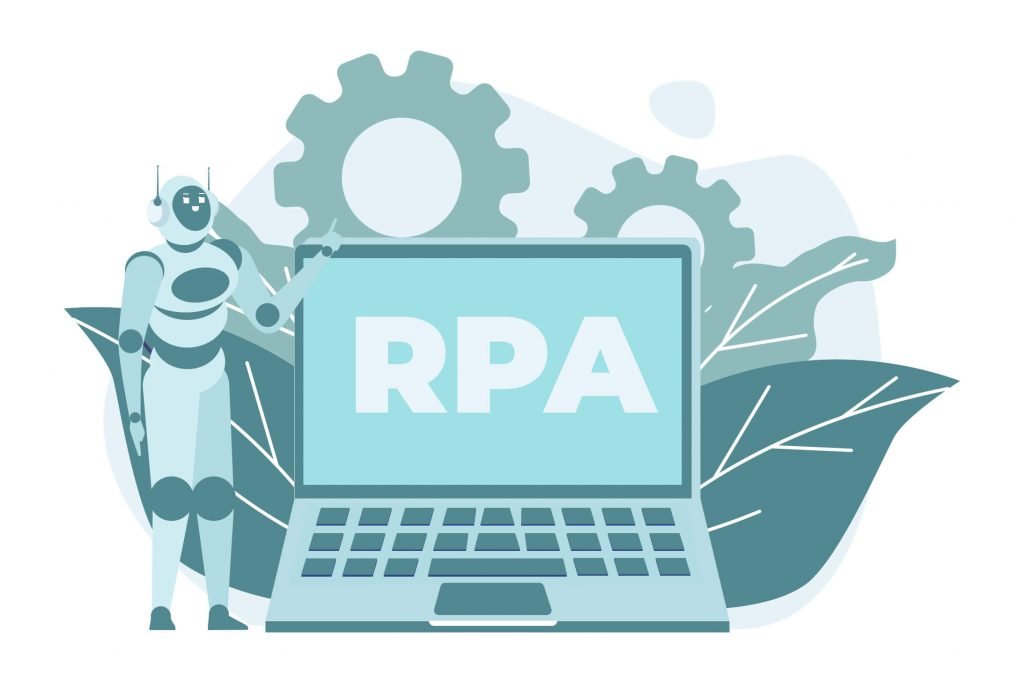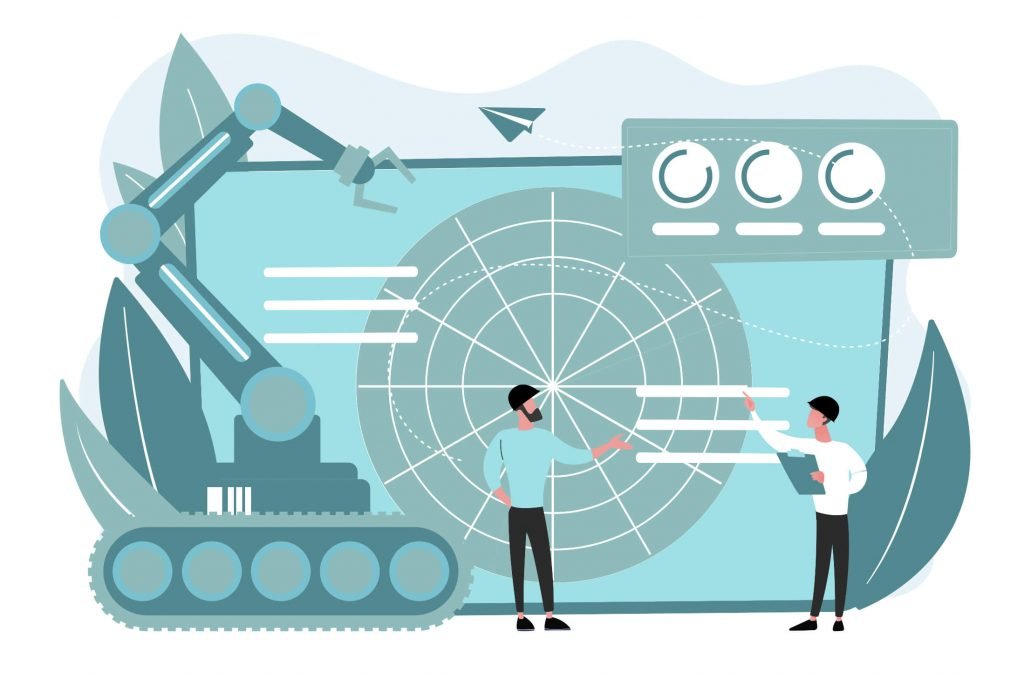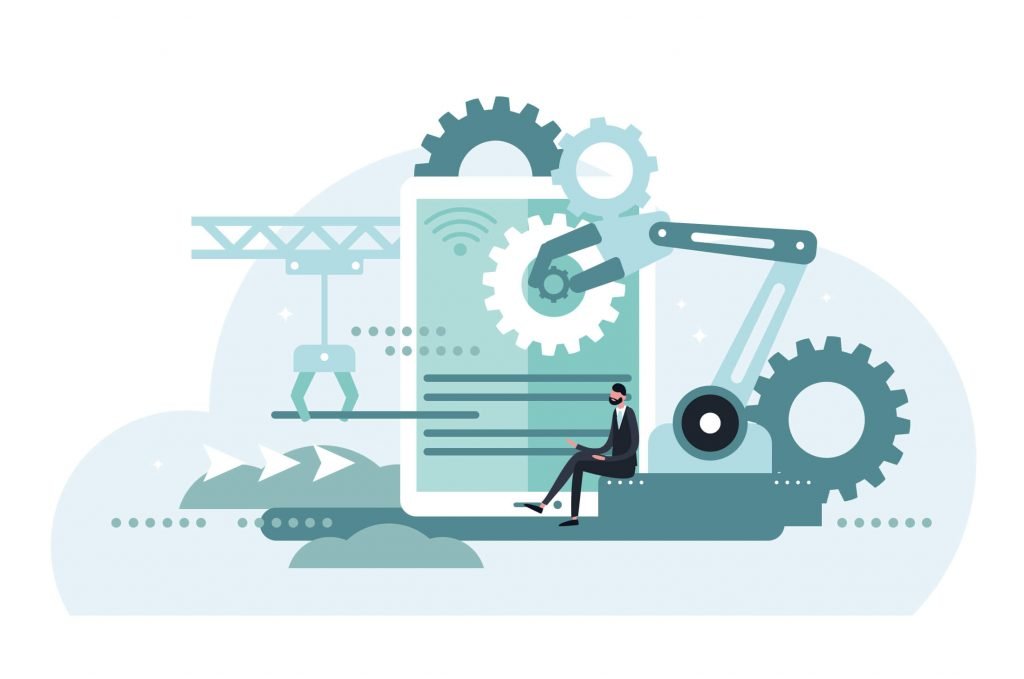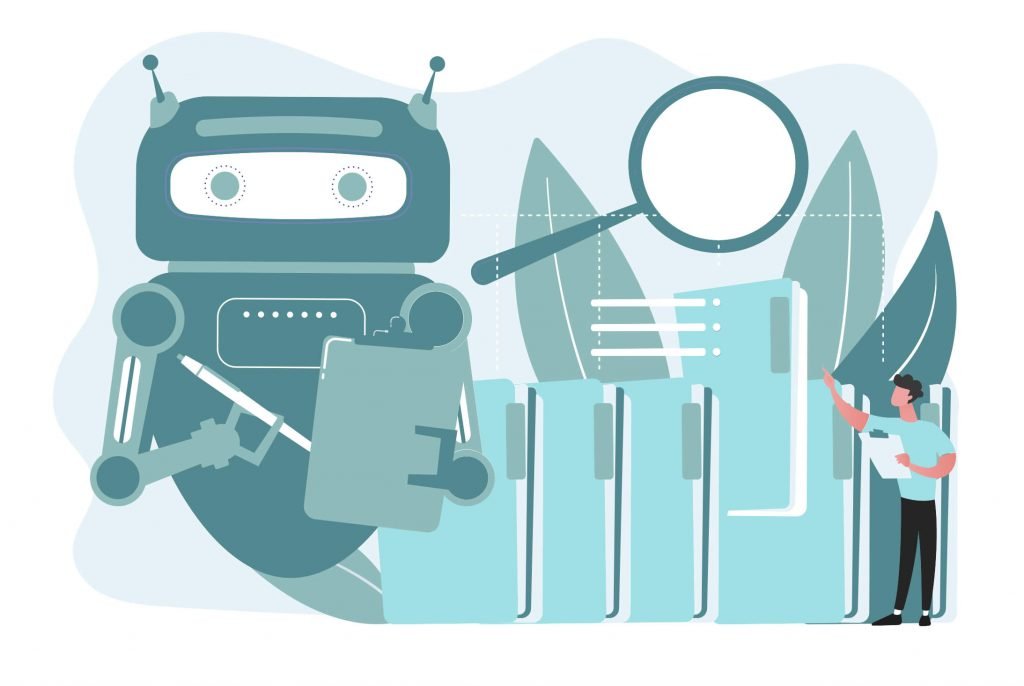
Picture
Robotic Process Automation (RPA) is a combination of technologies resulting in the automation of structured, repetitive and routine office tasks, which your employees perform using a mouse and keyboard in any of your IT systems. RPA is an excellent tool for tasks that are driven by procedures, schedules, and instructions. Due to robots your employees gain support in the most tedious tasks and can spend more time on projects that require creativity.
Automation works great regardless of your industry, including all kinds of shared services – finance, accounting, HR – as well as customer care, banking or health services. RPA supports a full range of applications – starting with “black” terminals (command-line interpreters) through all kinds of window applications to the most modern web applications.
The reason why RPA is growing so quickly is because it is inherently well suited for automating areas where the key to success is to implement robots in a reasonably cheap and fast manner. RPA platforms allow for easy, inexpensive, and quick development of robots, even if the office tasks to automate are complex. It is a key feature when compared with traditional software development which most often is not economically justified in places where the solution is quickly deployed robots. It is important to note here that despite the fact that RPA development is easier than traditional software development, it still requires certain amount of specialised software engineering expertise and tools to be efficient at a sizeable scale.
A robot works best while doing tedious, boring, and repetitive tasks that require a lot of attention to details and accuracy and which tend to generate many human errors. Processes that have characteristics described below are perfect for automation. However, in the real life they rarely meet all of these conditions. Most processes must have at least some of these features to be good candidates for automation:
Usually, employees find the tasks with such features the least appealing. As a very general rule of thumb we can assume that a robot can do the things which people simply don’t like doing.
RPA has recently become a tool that raises enormous interest because of its versatility and effectiveness. We are possibly experiencing a revolution that might result in disrupting the paradigm which claims that any automation in office operations is entirely the responsibility of IT teams. One of the strong points of RPA lies in the fact that it passes some of the automation powers to business owners of the processes.
RPA is best applied to tasks which people dislike the most. It is, then, fully justified that introducing robots to work together with office workers is becoming more and more popular.
However, widely popular technologies can be implemented spontaneously and without proper preparations. Our experience proves that to succeed you need to apply relevant tools to the right tasks. Being familiar with the benefits you can gain from these tools is essential for setting reasonable expectations.
RPA is not the answer to all current challenges of office operations but it helps achieve gradual and concrete advancements whose positive impact accumulates with time. If you implement automation well, you can gain tangible benefits:
Robots may not be the answer to all challenges in back-office operations, yet the benefits of having them on board are tangible and achievable in a short time. Robots only relieve your team from the burden of doing the least interesting tasks, but they are also a perfect solution to increasing or irregular volumes of work.
Most robots strictly follow the procedure that is programmed up-front. This procedure can sometimes be very complex because of the nature of the underlying business process. This allows the robot to work with 100% accuracy at all times. Robots can always explain why they made specific decisions and why they chose a specific path based on a specific situation. This makes them absolutely deterministic and perfectly fit for operations where the result has to precisely comply with procedures.
However, in some situations one can benefit from applying elements of artificial intelligence, especially when robots make some preliminary work, such as searching through databases to prepare data for humans to process. An example of such a task can be reading incoming emails and flagging them with different categories. Even if the process is not 100% accurate it can save employees a lot of time when reading all communication.

Picture
If you’re currently wondering whether process automation is the right answer for the challenges you face, it is worth examining why others opted for this solution. RPA is a powerful tool in enhancing your company operations and making a leap toward digitalisation. However, like any tool, it is essential to identify the most relevant issues it can fix.
Below we present 6 main reasons why businesses automate their processes using RPA.
In most companies, if not all, one thing is certain: IT resources are scarce and the choices made in terms of what will be developed by a technical team and what needs to wait till “unknown future” are always difficult. Moreover, IT development is generally expensive, which results in very careful decision-making with a heavy emphasis on the business case the investment is to generate. These observations lead to a simple generalization that IT resources are usually more likely to be placed into front-end business development areas which have a larger impact on the top rather than bottom line.
The introduction of new technologies, channels, business lines and products very often leads to increased complexity in the back office. In an ideal world this complexity should be unnoticeable to us and solved by automated interfaces and applications. As most of us know, in reality this is rarely the case. Very often at the start of the implementation process a lot of technology results in an increase in manual work in the back office.
Keeping that in mind, RPA fits perfectly in such an environment. It is much more economically justified, has a far simpler development process and yields benefits faster than a typical IT development. RPA is usually less challenging technologically (though in terms of the processing complexity RPA often is still quite a task to face), hence specialists in advanced IT technologies are often simply not needed to automate back office operations. That is why RPA is very often the right answer to challenges that back-office operations are facing in the area of automation and technological advancement. Robots in the back office also allow for shifting IT resources areas based in more sophisticated technology and showing better potential to result in business development.
According to the Talent Shortage 2020 survey, Closing the Skills Gap: What Workers Want, conducted by Manpower Group in 2019 70% of employers in Poland found it difficult to find new employees. Talent shortage is a challenge for 54% of organisations worldwide – this is the recorded highest rate since 2009. Talent shortage on the job market results in people changing their jobs more often and their expectations rising. Current and forecasted demographic trends do not improve this situation.
Back office operations have one typical feature: very often their team consists of a relatively stable core of a specialist group, more suitable for advanced tasks. The other part of the team usually experiences higher turnover as it typically consists of less experienced employees who are very often assigned to less challenging and more tedious tasks. Though such a set-up can be managed and teams should have a sufficient blend of skills to maintain high motivation across the team, it is not always achieved. In such a situation the turnover is consistently high, which leads to higher recruitment and training costs.
Tasks that are generally disliked by workers due to their repetitive, tedious and error-prone character are the most suitable for robots. Hence, having robots on board can significantly reduce turnover and increase motivation because people can focus on more challenging and satisfying tasks. Robots are also easier to train, don’t quit the job or ask for a raise, which increases stability in terms of the back office operations management.
Our experience shows that most organisations struggle with the fact that there is too much work to do compared to the number of people available to do it. Maintaining the right team that can do all the heavy lifting in the back office operations is a challenge in itself. Unfortunately, in many workplaces people still perform tasks that should have been automated long ago. According to a McKinsey and Forbes report, Shoulder to shoulder with robots, in Poland “49% of working time is spent on activities that could be automated.” That includes repetitive, tedious and error-prone processes. Such tasks, perfect for robots, negatively impact employees’ motivation, engagement, and attention at work.
Assigning boring and least liked processes to robots allows employees to dedicate the time they’ve saved to more challenging and engaging projects. Working together with digital teammates, employees gain more opportunities for growth, which boosts their motivation. At the same time productivity of the team increases because robots do their job with uninterrupted attention and full engagement. The implementation of a new technology also results in a much more interesting and appealing workplace.
Hence, having robots on board generally raises motivation as the most unwanted jobs can be done by them and people, having Digital Teammates working shoulder by shoulder, can eventually focus on more creative and developing tasks what eventually leads to much more attractive workplace.
Correctly prepared and trained robots don’t make mistakes. They always work according to instructions and never mistype or miscalculate or generate any other errors, which become more likely to happen, the more repetitive and tedious a task is. Robots are the fastest and simplest way to improve the quality of your operations.
Robots boost the efficiency of operations because they perform tasks with an unwavering focus. They can’t get distracted and pulled away from the tasks they’re doing. Their attention isn’t negatively affected even by many hours of processing large amounts of data in several applications. In contrast to people robots don’t take sick leaves, holidays, or even breaks.
When processes or applications change in any way, digital teammates – after relevant reconfigurations are made – easily start following new instructions. In a similar situation people usually need more time to get used to changes in procedures or a software interface, and it’s even easier to make a mistake or work slower in such a case. What’s more, you can monitor online how robots are working at the moment, and their work is more stable and predictable.
AI is always an interesting step to take when a technological advancement in operations is considered. For many processes it is appealing to implement algorithms that can do the job, but do not need to be deterministically designed in 100% of cases prior to the deployment.
AI elements in automation differ significantly from pure RPA, which is 100% deterministic. With pure RPA, the input data are strictly specified, procedures are fixed and fully known and the output is always predictable and can be tracked back if needed.
AI is never error-free, as one of its features is that it is learning with time and increases its efficiency over time. This on its own means that RPA processes are easy to design as robots can be simply placed within a process and we know exactly how many cases will be done by robots and what results will be achieved. AI does require human supervision or second-hand checks, which necessitates a process redesign to make sure that whatever AI is doing won’t eventually have an unexpectedly negative impact.
This is why robots with AI are more challenging to successfully deploy. It is advised to start with simpler RPA robots at first. This is particularly important from a psychological point of view as well-designed RPA robots yield positive results from day one after the deployment. In situations where AI requires some time to learn how to do its job, the team needs to maintain a certain level of patience and understating for the new technology they’re working with side by side.
Teams that have already experienced how pure RPA robots can help with their daily job are better prepared to welcome AI additions to the team.

Picture
The process of implementing robots into your company can look differently, depending on the implementation model you choose. The most common model on the market is to purchase robots. A company automates its processes in-house and the preparations before automation are much more complex than when you decide to opt for the Rent-a-Robot model described below. When considering in-house automation, you need to take in account:
You can also reach out to external consultants for help in developing RPA projects, but that significantly raises an already high investment right at the start of the project. A new technological project definitely requires some engagement from your IT team and it’s important to identify the people who will support the RPA Centre of Excellence and the infrastructure needed to maintain robots.
To achieve a scale where you can deem an in-house implementation a success, you need RPA experts and a separate Centre of Excellence. If you decide against hiring specialists, you will still need extra training and courses for people in your organisation who would like to learn new skills. That definitely means additional costs and time dedicated to the project. Because RPA is an area on the edge of technology and business, not all employees want to develop in that direction. When they do decide to learn RPA, the reskilling process needs additional support from your HR department.
Once you have the necessary teams, licences, skills and infrastructure, you can go on to select processes to automate which are right for this technology and fit its logic. RPA developers will start designing robots on the basis of documentation that’s usually prepared by the person in charge of the process.
Due to the required resources, from its very start in-house automation calls for reorganisation, hiring of new talents or the creation of a dedicated reskilling program, and significant investments in IT. There is, however, an alternative that doesn’t force you to build internal competences and reduces the time needed to deliver first robots.
Such an opportunity is offered by the Rent-a-Robot model (Robot as a Service). With this model, the most important aspect you need to focus on is the selection of the first process to automate. You don’t have to spend time choosing software, preparing the infrastructure or assembling a team of specialists. Once the process is selected along with the applications it’s based on, the robot vendor only needs application access for robots to start developing them.
In this model there is no need for detailed mapping of processes, documentation or any other sophisticated preparation to start automation. All you have to do is to show specialists what your employees do. Usually, a workshop that takes a few hours are a good and sufficient start though a fully functioning robot – digital teammate – can be developed even on the basis of a recording that shows how the process is done.
The initial stage of the project can be shortened as much as possible in this particular model. Due to this first robots are deployed in the production environment within a few weeks. This process makes identifying other process to automate more natural because the growing experience in working with robots lets employees thoroughly discover the benefits of robots.
As mentioned earlier, in the case of in-house automation the implementation process starts with selecting RPA software, building a team with relevant skills, and preparing the infrastructure. Next, you have to choose processes to automate, which is usually done by analysts who assess the automation potential.
The selected processes should meet certain conditions. What’s important here: not every processes has to be automated from start to end. You can also benefit from automating just a section of a more complex procedure. After a process is selected, you have to prepare documentation, which developers can use to create a robot.
After the development stage testing starts to ensure that the robot functions correctly. Any mistakes should be detected and fixed at this stage. Only when the robots passes all the tests, it can be introduced to the production environment.
You have to remember, though, that even after a successful implementation processes and applications can change, which might interrupt or disrupt the robots’ work. When that happens, specialists have to reconfigure robots accordingly so that they can function correctly and the process can keep running smoothly.
In a typical implementation process it’s you and your company who are in charge of each stage of automation. However, in the Rent-a-Robot model (Robot as a Service) we usually begin with identifying the automation potential. Next, our analysts choose the most promising ideas which will be implemented by Robo Shepherds. Before robots, digital teammates, are deployed in production, we conduct careful testing whose results is then accepted by the Client. Each running process is strictly monitored both with automated tools and by Robo Shepherds. This cycle is repeated continuously as long as there is still some automation potential to explore. Each cycle takes from 2 to 6 weeks and always results in deploying robots to do actual work.
When you decide on in-house automation, you have to take in account the following costs:
One of the very important factors of estimating costs of automation in this setup are the resources spent on the Centre of Excellence. That is particularly crucial for international organisations which tend to have R&D and IT competences located in more developed countries and back office operations outsourced to places with lower employment costs. Such a setup increases the pressure on automation and requires an even larger scale as development of robots is more expensive than the costs of back office. Achieving economic benefits is even more challenging, then.
Typical smaller automation projects take between 6 and 12 months and consists of a strategy, process analysis, process optimisation, and identifying the automation potential. This approach is made even more complex because further automation and the maintenance of robots requires having RPA developers and a part of Centre of Excellence on board. That means that without careful prior planning automation in such a mode might not meet the initial economic analysis.
This is why in-house automation is recommended for larger organisations whose automation potential could optimise hundreds of FTE. Given significant investments and preparations, in larger organisations the benefits of automation can bring a return of investment and actually meet expected targets. For companies with smaller potential such an investment is simply not justified economically and automation can be particularly difficult to implement.
An alternative solution that, in contrast to in-house automation, is within the grasp of medium-sized and smaller businesses is the Rent-a-Robot. With this business model you don’t have to invest in acquiring internal RPA skills, licences or special infrastructure to have a team of robots that function in a production environment. You start paying for automation only when robots developed by the vendor (for Rent-a-Robot, that would be Digital Teammates) start doing actual work.
The salary of the rented robots is a fraction of the cost of an employee who did the same work before automation. With Rent-a-Robot you don’t bear the costs if creating and maintaining a team that would develop and maintain robots, which usually translates into many months and resources spent on recruitment, onboarding or reskilling employees, and later ensuring they have growth opportunities. When you rent robots, the only costs you have to consider are the renumeration paid for the work the robots did in a specified timeframe. Automation in this case is considered financial saving from the very start of the project.
Typically, robots start their work 3-6 weeks since the start of cooperation. What is even more important, in Rent-a-Robot mode Clients do not need to invest in RPA competences in order to have fully functional team of robots on board. In such mode robotization is considered as a straightforward saving from day one rather than a cost.
In the traditional model of in-house automation the process of delivering the first robots can take even several months. You also have to add the time needed for preparations – creating the Centre of Excellence, preparing the infrastructure, choosing software and process, to name a few aspects – which can several months more. As your company acquires internal skills and experience, the time needed to develop robots might be reduced, though that depends on how complex the process to automate is.
When you decide to rent robot, it typically just takes weeks to implement automation. For the simplest processes it can be even as little as a few days. For complex processes building robots can take up to a few weeks. It usually takes from 3 to 6 weeks from identifying a process to deploying a robot. The timeframe depends on the complexity of the processes, the scope of work which is to be redirected to robots, and the creation and assignment of all the accounts and accesses to applications.
The robot development stage needs to be preceded by the infrastructure setup. This varies in length from organization to organization. It can be, however, very quick and seamless if digital teammates can operate from a public cloud. Such a setup can take as little as a day.
Since our Robo Shepherd team can work on many robots at the same time, we are typically capable of automating an operations team of 100 people in 3 months, given that the typical automation potential ranges from 20% to 30%.
If you want to implement automation in-house, you need a team that will develop and maintain robots. RPA platform are often advertised as “low-code” or “no-code,” giving the impression that automation does not require a lot of IT skills. Automation can seem quite easy when you only have to deal with one or two robots, but scaling up to bigger numbers can be challenging and costly for a typical organisation.
Usually automation cannot be done as a part-time job and automation team members have to share their knowledge to replace each other in ordinary situations such as vacations or any other days off, especially when a company starts to rely on robots for doing the day-to-day job without interruptions. A typical automation team is similar to a software factory with complex engineering processes. Real cost efficiency with robots can be achieved through the effect of scale, which means that in most situations your organisation should aim to have hundreds of robots to cover the cost of the automation team.
There are also intermediate solutions on the market where consulting companies train employees for RPA skills or hire their own RPA teams for as long as you need to develop your own skills. Still, the goal here is to create your own robotics team, which is usually viable only to larger organisations which aim to automate hundreds FTEs.
The Rent-a-Robot model, however, lets you implement automation into your company without having to acquire RPA skills. It is the vendor who takes full responsibility for developing and maintaining robots, which is done by the vendor’s specialist teams. It’s a solution recommended for companies which can’t afford or don’t want to make large up-front investments in a new technology. This solution is also recommended for organisation whose automation potential doesn’t total hundreds FTEs, but it is still high enough that automation can bring significant benefits. When you rent robots, you can focus on your core business while still supporting it with a new technology.
Setting up a robotics team is very similar to building a software factory, even if the robotic platform you chose is “low-code” or “no-code.” Selection and assessment of the platform that meets your requirements best can be a quite difficult and time-consuming process, so you should probably consult specialists to help you with this. After you made your choice, you have to start thinking about filling some key roles in the process of robot development and – what is even more important – maintenance, which is necessary once robots are deployed to do the actual work.
These roles don’t have to be performed by different people and can be combined in most cases, but in general people work best when they can specialise in their chosen fields. What is even more important, once you start relying on robots doing day-to-day work, you have to make sure that there is always some human support available at work to solve potential problems.
In a typical automation process there are 9 different functions which need to assigned to create your own professional Centre of Excellence:
If you implement RPA in-house, your IT team has to set up the infrastructure which is necessary to maintain working robots. Depending on how you are going to acquire skills needed to build robots, you might also need to get a part of your IT team involved in developing and testing robots. However, you have to remember that IT’s involvement doesn’t end when automation is implemented. You will need a Centre of Excellence which will maintain the infrastructure, RPA platform and necessary tools.
When you rent robots, automation requires minimal effort from your IT. Robots attach to applications that your employees use, so no configuration or development changes are needed. IT is essential to establish a safe connection between robots and your working environment, as well as granting the robots access to your applications, similarly as when IT prepares the working environment for a human employee.
In the case of in-house automation, you have to make sure you have the right infrastructure. How you’re going to set it up depends on various aspects, including selected RPA software, the license you purchase and regulations that apply to your company and industry.
When you decide to rent robots, you don’t need any additional infrastructure on your part. With Rent-a-Robot the vendor (Digital Teammates) provides robots with any resources they need to do their tasks.
There are also the rare cases when due to specific regulatory requirements the solution has to be deployed within the Client’s infrastructure. Such an arrangement is fully supported and can be delivered in different operating models according to specific requirements. Clients can, then, manage only the physical infrastructure and operating system which allows the vendor to manage robots and take the full responsibility over the entire deployed solution.

Picture
Although automation is now regarded as a mainstream tool of digital transformation for enterprises, it is sometimes difficult to find a reliable source of information on tangible benefits automation can bring. There are obvious advantages such as the reduction of the cost of operations, improved quality and efficiency as well as many not so obvious aspects that were discussed in more detail in previous chapters.
As you consider implementing a new technology to the company, you probably take into account not only the benefits a solution can bring, but also potential factors that might make the implementation difficult or highlight some disadvantages of the technology. Below we present 6 most common obstacles that can appear on the way to automation and how you can overcome them.
It is generally assumed that 20-30% of all office work is within the reach of automation technology, but the actual potential can be much more than that, depending on your specific application environment. Here is a brief questionnaire that can help you identify the right processes to automate:
If your processes meet at least some of those conditions, they are most likely good picks to pass to robots.
After such a brief assessment you can go two ways depending on your organisation culture – either find some advisory help to analyse all your potential in detail upfront or start small with the first process, automate it, then build up your experience in an agile and iterative process of continuous improvement.
Here you also have a couple of choices. The most obvious one is that you might decide you don’t need robotics skills at all and let somebody else implement automation for you, ideally providing Robots as A Service. This is the best choice when robots are not your core business or your scale of operations does not exceed hundreds of employees. Another option is that you try to establish a Centre of Robotic Excellence on your own by acquiring talents on the market or by asking for some consulting services on how to establish and grow such skills.
Because robots work without changing the underlying IT systems and in a way hide inefficiencies of current user interfaces, they can be perceived as a “temporary” solution until “real automation” is introduced. The truth is that robots are a fully fledged automation solution that in most cases you find no other alternative. This is because usually there are valid reasons that automated low-level interfaces haven’t been built or systems haven’t been changed due to prohibitive cost. Robots by their nature are extremely lightweight and can be an excellent “bridge” until those “ultimate” solutions can be delivered.
Robots are now a part of mainstream digital transformation tools and should be used as a complementary solution to other automation efforts. The best way to avoid potential interferences is to simply put robots on your transformation roadmap after properly assessing their advantages over other activities. Big transformation projects usually take some time to implement, so robots are an ideal bridging solution. Robots are also a perfect option to fill some gaps in the ergonomics of recently implemented solutions, especially when some difficult decisions had to be made right before deploying a big new transformational project. Robots can give you some time to think about the target employee experience when it comes to interacting with newly built systems.
Even if a robotic infrastructure is usually less costly than typical IT solutions, it still requires some servers, either on-premise or on cloud, RPA licenses and, above all, a skilled team to keep thing running smoothly.
There are some ways to overcome this issue. One solution has been briefly discussed above: you can simply find a vendor of robotic services and pay only for the work robots actually do for you. Your upfront investment, then, is close to zero.
You can also invest a little more and go for trial or free versions of RPA platforms with lightweight cloud infrastructure, which is good enough to conduct a Proof of Concept of Robotic Process Automation and then try to scale it up. This approach is quite popular, but isn’t exactly recommended as results of small-scale implementations can be very misleading when the complexity of the solution increases.
There is a third way to tackle the problem, especially when your organisation has a culture of creating more formal business cases for potential projects. In most cases, properly assessed costs are greatly exceeded by the benefits of automation, so an upfront investment pays off in a relatively short time.
One of the most crucial issues to be addressed before robots are introduced is how to manage employees and their time once it is released by the robots. This problem is less pressing nowadays as in most of growing companies there is usually much more work to be done than the employees who can process additional volumes. If that is your case, you simply have to reallocate the work and give people more interesting, creative and value-adding tasks. When automation is done in an agile way, the change is gradual and continuous, so people have enough time to adapt and usually come back with more ideas of what the next robots can do.
If your automation project is going to be implemented in a more big-bang manner or you are mostly motivated by the reduction of your staff, you might need to plan employee relocation as one of the components of digital transformation in your organisation. There is plenty of advisory help you can find to help you deal with change management. However, a gradual and iterative approach to robotic implementations is strongly recommended because it aligns with robots’ lightweight nature better.
Of course, all new endeavours come with some risk of failure. Why is this risk, though, much lower with properly introduced Robotic Process Automation?
The most important reason is the fact that robots by their very nature are aligned with the agile paradigm. This means they can be implemented in a much shorter time and at a much lower cost and fewer stakeholders involved than typical automation project. This helps to achieve a positive feedback loop which provides a minor automation success leads to another minor automation success and eventually becomes a great transformational success of the entire organisation.
If you are dealing with other issues that hinder starting your robotization journey, please do not hesitate to share those. I’m sure we’ll find the way to overcome them. Robots are really your employees best friends!

Picture
Large-scale automation (that involves more than a few robots) requires the processes of creating, installing and monitoring robots to be automated as well so that the implementation can be more efficient. Robots are simply a piece of software that needs to be changed sometimes. They also operate on applications that might change every now and then, which can cause even more complications. When starting your automation journey, you need to be always prepared for both of these factors and have tools to manage them in an easy and safe way.
At the same time you want the development of robots to be a simple and pleasant work, rather than a constant fight to remove errors. That is why we developed several tools and standards that let us combine the ease of working on robots (and thus shortening time to market) with a high quality and low vulnerability to errors.
Here are some of the main elements that are a part of the solution Digital Teammates created to automate the robot manufacturing process:
The robots that leave our factory are always characterised by certain common features regardless of what systems they operate on and in what environments they work. This set of rules applies to both the manufacturing process (based on the best programming practices) and the construction itself (a set of rules that must be followed by all newly created robots).
A very important factor that can easily reduce the risk of possible errors is the standardisation of robots’ working environments and the automated process of preparing robots’ workstations. Due to this approach and dedicated tools, we are able to build virtual “desks for robots” quickly, significantly shortening time to market.
Our robots are tested automatically, and, more specifically, are tested by other robots whose only purpose is to detect errors in the test environments as soon as possible.
A fast and efficient installation of new robots also requires automation. Our robots use an integrated configuration management system, which helps to minimise the risk of errors and allows changes in the launching parameters without installing new versions of robots.
All operations performed by robots are logged (on several levels) and stored in a dedicated log repository. The structure of these logs lets us generate both technical and business reports. Our clients have online access to this data and can monitor how their virtual employees perform.
Why do you need to standardisation in your robot development and why would you do it in the first place? Let’s look at what and how we standardise this process.
All of our robots are built in a similar fashion. They are made of the main module for realising the client’s business process and other modules for different aspects happening around business processes (built the same way for all robots). We also maintain naming standards for elements of both the robot and the platform itself.
All business processes are divided in a way that lets us maximise the speed of robots’ work and allows us to scale robots horizontally. This divided business process makes change management easier and less susceptible to errors.
All of our robots use our central configuration management system and the configuration itself is used and stored in a standard manner.
Preparing the testing stage for robots is an inseparable element of each Robo Shepherd’s job. For every robot we create automated tests run by other robots.
Our robots always generate reports in which they describe what they’ve done. These are business reports that contain data about the business process. In addition, all operations are logged and stored in an external log repository. It allows us to monitor our robots online, both in business and technical terms.
Why do we standardise these elements?
Standardisation makes the process faster and cheaper (though at the beginning the opposite seems to be true). Due to standardisation new developers can start their work faster and it is easier for them to start automating new processes for different customers. Our standards facilitate change management, shorten the time needed to identify and remove errors and let us automate the installation of robots. Finally, it gives us more control over individual robots, which in turn lets us build entire robotic farms.
Standardisation is a process. Once created standard is not eternal or carved in stone. Our team reviews their standards from time to time (where we discuss their form) and if we decide that some element should be modified, we develop a new version. However, such changes must be properly justified and discussed and cannot be caused by short-term needs or function as a shortcut.
We know for experience that taking shortcuts always ends in unexpected issues.

Picture
Robots usually stop working when something changes in applications or processes, e.g. the interface is altered or one of the steps in the process is modified. If there is a dedicated Centre of Excellence in our company, the people who monitor the robots’ activities should notice the error due to special tools or the issue should be reported to them. Then the specialists should reconfigure the malfunctioning robot.
Robots won’t know what to do if they encounter an unexpected change in the process. This is why it’s so important to have a skilled, dedicated team, when you implement automation in-house, because this team detects errors and adjusts robots to the new situation as it is your company’s duty to manage the robots.
When you rent robots, normally it is extremely rare that robots stop working. The most common reason might be a change in the application that Robo Shepherds were not aware of. If this happens, we immediately start retraining the robot because Robo Shepherds not only build robots but, above all, also adapt it to changing conditions.
Of course. It is completely natural that business process are modified, applications and software is updated, or new regulations need to be applied and, as a result, alter the process. You have to remember, though, that when your organisation develops robots in-house, an internal team that maintains the robots is a must. In other words, a team of developers has to be ready to reconfigure robots when process or applications are modified.
When you rent robots, you can also modify your processes, but you don’t have to worry about robot maintenance and reconfiguration. We are fully aware that robots work in an active environment, where changes often occur. Our Robo Shepherds make sure that robots are properly retrained when their environment changes. While renting robots, we also make sure that robots are able to do their job. This means that if a process changes or if an application on which the robot operates, our team quickly adapts the robot to this modification.
That is why it is important that the processes you choose to automate are relatively stable and don’t change too much. If processes or systems change on a weekly basis, the reconfiguration or the potential resulting stoppage might hinder smooth operations, regardless whether it is your or your vendor’s duty to reconfigure robots.
Most of the international, renowned RPA platforms are built with the highest safety and compliance standards in mind and applies various solutions to further enhance data and process safety, e.g. with data encryption. Many of these platforms are also successfully used in strictly regulated environments (such as the banking industry).
If you opt for in-house automation, it is recommended that you learn more about these platforms and their safety measures or reach out for expert advice. Safety measures should be taken into account at each stage of robot implementation and operations. The basic aspects here are, for instance, granted accesses or monitoring robots’ actions.
One of the most important aspects of any automation project is being 100% sure that you have full control over robots’ actions. It is impossible for any human supervisor to watch more than just a few robots running at the same time, especially when they run in virtual environments without computer monitors attached.
Similarly to previous cases, with in-house automation you have to ensure you have the right monitoring tools and design a systemso your company can optimally supervise robots and their actions.
When you opt for renting robots, monitoring and supervising robots become one more element of automation that you don’t have to worry about because the vendor takes care of it. For instance, in the Rent-a-Robot model we use a highly scalable monitoring system that automatically checks all the robots at all times as they’re working and reports all important issues to a human supervisor. It is absolutely essential to be able to accurately select the few crucial messages from millions of events that robots generate during their workday and react accordingly. Such an approach, accompanied with tools we developed lets us monitor and manage even hundreds of robots in different environments, making sure human supervisors receive targeted information that requires their attention.
As you can imagine, the decision to introduce robots that perform tasks handled by people can be a controversial subject for human employees. Mere communicating such news can trigger many different emotions and result in deep discussions. Both the surprise and fear of the change itself and the potential loss of daily tasks can turn out to be a daunting hindrance, if they’re not addressed in time.
Helping employees get familiar with the subject and informing them what the planned changes mean for them in a transparent way is always a good start. Let’s not be afraid to say that robots will actually do some of our employees’ work, but at the same time, we must not forget to emphasise that robots will handle the least liked tasks. You can also clearly explain that right now there is much more work to do than available resources as your employees experience this reality every day at work.
A good introduction is one thing, but the best way for people to grow familiar with robots is to get them involved in the development process and launch robots as soon as possible. The immediate transition from theory to practice is crucial because it helps employees understand that robots are their allies, not enemies. By handling the most repetitive and tedious tasks, they allow people to focus on the more creative aspect of their work and strongly emphasise the expert status of our human crew. Supervising the tasks carried out by robots and simultaneously handling the most unique, complicated, and complex cases give human employees the opportunity to further broaden their expertise.
Reluctance related to the employees’ fear of the unfamiliar, new technology is also easy to overcome by showing people that they are necessary for robots to complete their tasks correctly. The technological aspect and familiarising people with the way RPA workshave an additional value, which is worth emphasising in conversations with your teams. Considering the dynamic growth of popularity of robotic solutions combined with their relative novelty, the first-hand experience, gained by working with robots side by side, will be exceptional and almost exclusive to your employees. This is another aspect worth emphasising.
In practice, implementing robots can work wonders, especially if your team has to deal with sudden spikes of volumes. Employees quickly notice that due to digital teammates they are no longer asked to work overtime to handle additional volumes. The robots will gladly handle them without any complaints and thanks to that your team will be well-rested and much more effective.

Picture
Most businesses face the challenge of having too few people to do all the work that has to be done. The increasing pressure is particularly noticeable in back office operations as it makes employee retention difficult. On top of this, many tasks that people are doing should have been automated a long time ago. These repetitive, tedious and error-prone tasks are perfect for robots and shouldn’t be done by people anymore.
A typical team of 10 people usually consists of 7 more experienced and advanced specialists and 3 more junior members who are much more prone to employee turnover. This naturally leads to a situation where it is tempting to assign the more tedious and repetitive tasks to the less experienced workers, which fuels the turnover even more.
Hence, having robots on your team generally raises motivation. As robots do the most disliked tasks, people, working side by side with their digital teammates, can finally focus on more creative tasks that help them grow, which eventually leads to a much more appealing workplace.
Typical automation potential ranges from 20% to 30% of processes so robots are perfectly fit to fill in positions that see the highest turnover. The whole workplace immediately becomes way more attractive for the whole team, including newcomers.
Robots definitely mean new opportunities. All around the world too many people do tasks which are not made for humans, but are perfect for robots. This covers tedious, repetitive, error-prone assignments which often cause decreased motivation among team members. According to Gallup’s report “worldwide employee engagement is only 15%,” which results in lower efficiency. Boredom and lack of engagement among employees only exacerbates the tedious nature of their tasks.
Every single member of management we have talked to can think of hundreds of better and more creative things people could do, were they not forced to spend so much time on tasks that people find frustrating while robots really enjoy doing them.
The more robots are deployed in workplaces, the more satisfied and motivated people will be at work. In the foreseeable future robots are very unlikely to start posing a threat to humans on the job market as for many years we will observe the pattern where there is way too much work to be done.
However, automation opens up new opportunities. People who work together with robots have a chance to develop their skills as robots do the repetitive work whose tedious or time-consuming character wouldn’t allow people to grow. In workplaces that deploy robots employees more and more often handle more complex cases or spend more time on working directly with clients.
At the same time new professions keep emerging along with more opportunities to get reskilled and enter a career path related to robotics and automation. A real-life example of this are the Robo Shepherds who create and maintain robots. After deploying robots in our operations we provided our employees who had no IT background with an opportunity to start working with technology. Such an opportunity would never be possible without robots. We expect automation to open this particular path as people will have more opportunities to realise their creative potential.





